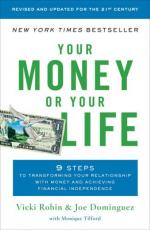
|
| Name: _________________________ | Period: ___________________ |
This test consists of 15 multiple choice questions and 5 short answer questions.
Multiple Choice Questions
1. How is a real hourly wage figured?
(a) Divide real hours worked by work expenses.
(b) Divide real hours worked by real pay.
(c) Divide real pay by actual hours worked.
(d) Divide real pay by real hours worked.
2. What attitude do the authors want readers to carry?
(a) No pain, no gain.
(b) No guts, no glory.
(c) No harm, no foul.
(d) No shame, no blame.
3. Some people reach the top of their profession and make good money, yet are still not what?
(a) Married.
(b) Happy.
(c) Wealthy.
(d) Secure.
4. Why should people not budget their money?
(a) Budgeters feel as if they are giving up something they love.
(b) Budgeters are inclined to mathematical error.
(c) Budgeting takes time away from family activities.
(d) Budgeting increases spending.
5. What do most people claim to value more than money?
(a) Their jobs.
(b) Their lives.
(c) Their health.
(d) Their talents.
6. What is budgeting similar to?
(a) Mathematics.
(b) Dieting.
(c) Filing taxes.
(d) Reducing income.
7. Why do many people give up time with family, working on hobbies, and fulfilling dreams?
(a) They fear success.
(b) They are lazy.
(c) They are too busy working.
(d) They are insecure.
8. What is the purpose of dividing income and expenses into categories?
(a) To determine if enough money will be available for retirement.
(b) To judge whether expenses are worth the life energy spent.
(c) To determine net worth.
(d) To decide if a career change is warranted.
9. People should spend only until they are fulfilled, just as they should do what?
(a) Work only until they feel fulfilled.
(b) Gamble within a preset limit.
(c) Drink in moderation.
(d) Eat only until they are full.
10. What is the second half of Step 2?
(a) Saving as much money as possible.
(b) Selling unnecessary luxuries.
(c) Looking for a better job.
(d) Keeping meticulous track of every cent that comes in or goes out.
11. Why do people buy more than they need?
(a) To fight inflation.
(b) To donate to charity.
(c) Greed.
(d) Survival instinct.
12. On average, what do Americans have less of than ever before?
(a) Education.
(b) Children.
(c) Debt.
(d) Savings.
13. Under which category does money paid to employ servants and service workers fall?
(a) Keeping up with the neighbors.
(b) Work-related expense.
(c) Cultural.
(d) More is better.
14. What allows people to enjoy their planet, community, and spirituality more than ever before?
(a) Being green.
(b) Retirement.
(c) Taking more vacations.
(d) Living frugally.
15. In Question 2, what must participants ask if each expenditure is in alignment with?
(a) Statistical norms.
(b) Their values and life purpose.
(c) Hours spent at work.
(d) Family needs.
Short Answer Questions
1. Each person has only a limited amount of what?
2. How often should people total their income and expenses?
3. Which perspective is feeling connected to a certain social class part of?
4. What is an important aspect of the second half of Step 2?
5. What must people do in order to make Step 3 work?
|
This section contains 498 words (approx. 2 pages at 300 words per page) |

|




